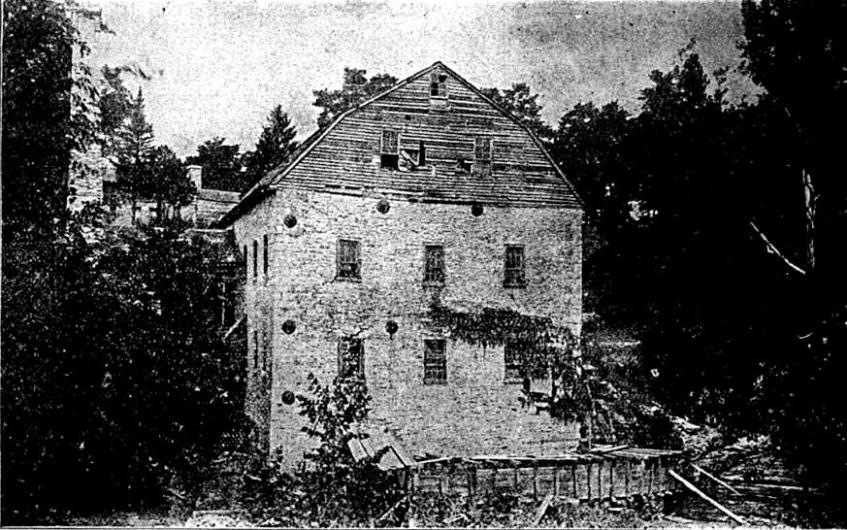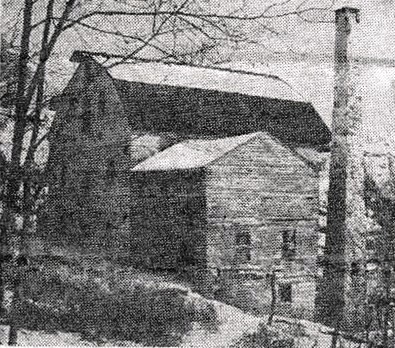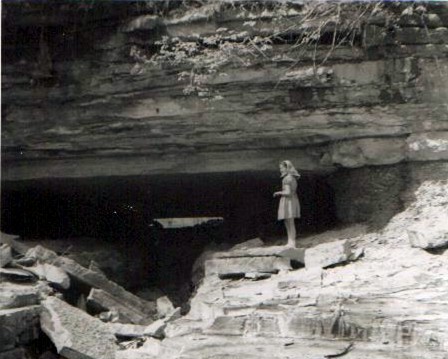THE TUNNEL MILL
Supplement of The Vernon Journal
Dec. 29, 1898

Herewith we give a view of the "Old Tunnel Mill" located one fourth of a mile south of town, in a delightful valley, overhung by massive forest trees, amidst the winding of the beautiful Muscatatuck. Frowned upon by cliffs and hills, and dancing in the rays of light reflected from the ripling brook, moss grown and draped with clinging vines, the old stands as a sentinel of the valley, firm, resolute, silent. Unmoved by song of birds, by summers gentle breeze or howling winter storms, it stands solitary and grand as a monument to the enterprise and energy of our ancestry and presents a view, which to behold, inspires poetic thought.
The old mill is a massive stone structure, erected early in this century (probably in 1825) by Ebenezer Baldwin, who ground wheat and corn and hauled the products with ox-teams overland to Madison to be sent by the river to Pittsburg or shipped it by flat boat down the Muscatatuck for New Orleans.
The power is furnished by a race constructed in a tunnel through a hill and connecting two points of an abrupt curve in the River.
The tunnel was made by an old pioneer engineer. Col. John Vawter and considering the date at which this work was accomplished it was an expert piece of engineering.
It was near this old mill that a Mr. Dixon, who was prospecting for oil in 1865, struck gas and at the same time struck consternationn to the minds of the inhabitants, who knew not what it was nor what to do with it and after most heroic efforts they succeeded in extinguishing the flames, and filling up the well, they breathed a sigh of relief that the "end of the world" had not yet really come.
The mill has passed through various hands and in its time has been patronized to some extent by all of the old citizens of the surrounding county, each of whom has an experience to relate in connection with the mention of this historic structure.
For the last ten or twelve years it has been owned and operated by Mr. George Herron, and at this day within its venerable walls may be heard the rush of water and the rumbling of the great water wheel as it lazily performs its task of turning the dust covered machinery, and even yet according to its owner's opinion from the products of this mill is produced the most wholesome biscuit, the sweetest corn-bread and most delicious buckwheat cakes.

The Old Tunnell Mills, The Most Picturesque Spot in the Entire County
It Is Here Many Picknickers Meet and Wile Away Idle Hours Recounting Stories of Other Days
"There's a path by the long deserted mill,
A stream by the old bridge broken,
A place where the willow's boughs bending low,
Over the green mossy banks where the violets grow."
A stream by the old bridge broken,
A place where the willow's boughs bending low,
Over the green mossy banks where the violets grow."
Of all the spots cherished by former citizens of Vernon and the currounding county the "Tunnel Mills" heads and it is justly entitled to that endears the place to his memory. When the mill was built can not be told exactly but it was between the years 1824 and 1832 by Ebenezer Baldwin and a Mr. Alling, of Madison.
Later on the stone dam, which is now badly shattered, was built across the Muscatatuck and also the tunnel which is 250 feet long and 8 feet wide was constructed. This tunnel was dug through solid rocks and required several months to build it. It was considered the greatest piece of engineering in the state.
At first the water flowed through the tunnel and onto a huge overshot wheel, but in a short time it was taken out and a turbine installed. This was way back in the days before there was a railroad in the state and people came to the mill for miles around on horseback carrying their grain in packs fastened to their horse's sides. A little later the roadway now almost extinct was made around the Muscatatuck and grain in larger quantities was brought in and after being ground into flour and meal was hauled to Madison and then shipped to Cincinnati and Pittsburg.
But the Tunnel mill was not the first mill around Vernon by any means. The Branham mill on the south fork of the Muscatatuck was probably the first mill built. Another one, the ruins of which are yet to be found covered by underbrush, is located on the Boner farm. The history of this mill seems to be entirely lost.
When the Tunnel Mills was in her palmy days it must have been a picturesque spot for now even though the place has decayed and has been neglected it is a favorite picnic spot. Hundreds of names are written on the majestic old walls dating back many years.
In 1865 a man by the name of Dickson came from the east on a prospecting tour and deciding that there was oil near the mill commenced to dig a well. One evening while inspecting the work with a lantern, gas was discovered which blazed several feet high and caused a sensation throughout the state as gas was an unknown quantity in Indiana at that time.
Mr. Dickson was terribly wrought up over his discovery and it is told that some Vernon people actually offered up prayers that the end of the world might not come. Every known means to extinguish the blaze was made, but without success until finally someone picked up a board and struck the flame sideways and cut it off from the pipe.
The mill has changed hands many times since its erection and the present owneeer is George Herron, an uncouth old man about 69 years of age, who lives with his wife in the house on the ridge just back of the mill. To be entertained one must give "Uncle" George a small coin and then he will do his best as a story teller.
Mr. Herron has not been able to leave his home since New Year's Day owing to a severe spell of sickness.
Pictures Below
During one of my family visits after our move to Califonia my grandfather Francis (Frank) Stewart took us for a picnic to the site of Tunnel
Mill, this would have been in about 1951. Grandpa died in 1953 so it would have been during one of his last visits home. The pictures below were taken by him, one is
of the chimney from the mill, the other is of me standing where the water used to come through the rock.

You may use this material for your own personal research, however it may not be used for commercial publications without express written consent of the contributor, INGenWeb, and